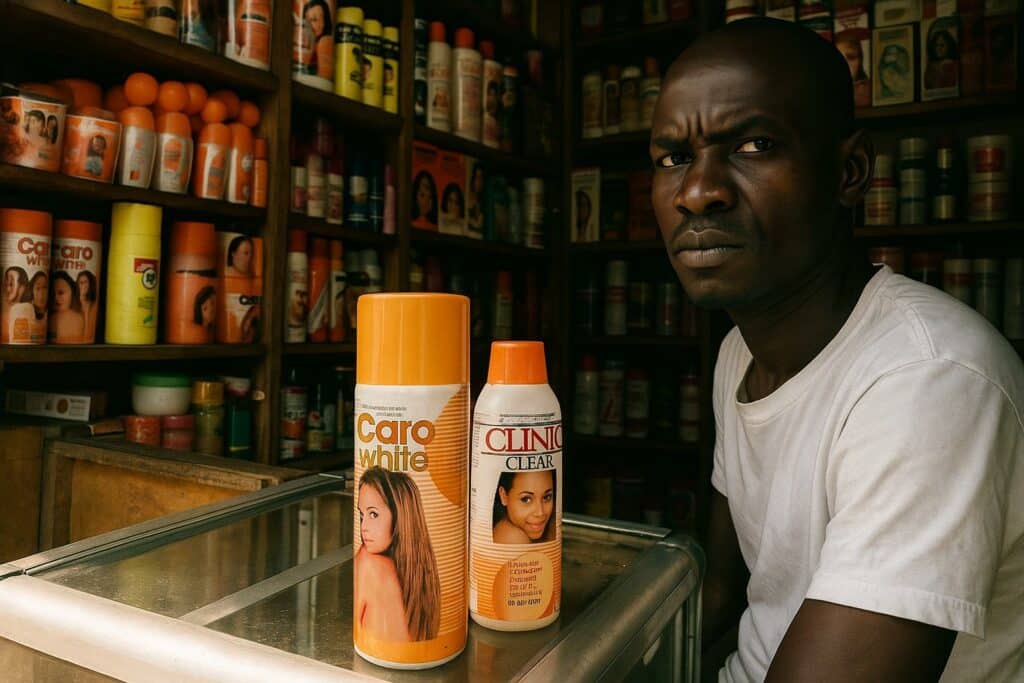Diaspora Spark, Local Echo
Under the noon heat that crowns the Moukoundzi Ngouaka School of Fine Arts, Alioty shoulders his canvas bag and recalls a not-so-distant era dominated by lightened faces. “It began with those coming back from the diaspora,” he reflects, underscoring how returning Congolese once displayed chemically brightened complexions that soon became aspirational for younger residents in Brazzaville and the hinterland. The practice, which initially trickled in as a symbol of cosmopolitan mobility, rapidly fashioned its own local following, turning cosmetic shops into discreet apothecaries of depigmenting lotions.
Colonial Shadows on the Mirror
Sociologist Eric Aimé Kouizoulou locates the allure of a paler epidermis in deeper historical strata. “The psychological effects of colonisation persuaded many that lighter skin was superior,” he observes, connecting individual choices to a collective memory forged under foreign rule. The comment resonates with a broader self-interrogation unfolding across Central African societies, where the residues of imposed hierarchies continue to influence aesthetic codes long after their political scaffolding has disappeared.
Health Risks Shift the Balance
Practical experience has added a more immediate layer of caution. Didier Clotaire, now a civil servant, abandoned bleaching products once he witnessed the dermatological toll: persistent lesions, heightened photosensitivity and the spectre of skin cancer. “You can age overnight under the sun,” he warns, urging compatriots to “remain as we are”. His testimony echoes street-corner conversations in Bacongo as well as discreet consultations in neighbourhood clinics, where physicians are confronting complications they link to prolonged use of corticoid-based creams and hydroquinone mixtures.
The Turn Toward Natural Care
A palpable shift is gathering momentum among the under-30s. Chimène, 25, counsels friends to avoid “decapage”—the local term for chemical peeling—while conceding they are free to “look bizarre” should they persist. Instead, she endorses everyday staples such as pure coconut oil, shea-infused formulations or the widely cherished Mixa lotion, all seen as kinder agents preserving the skin’s chromatic integrity. Beauty observer Bazin Mboungou interprets the phenomenon as “a return to authenticity”, a quiet but decisive renunciation of any notion that one ethnic phenotype stands above another. The reversal has been visible for nearly a decade, he notes, and shows little sign of ebbing.
Cultural Confidence and Subtle Diplomacy
The resurgence of natural skin pride also dovetails with a broader narrative of cultural self-confidence championed in official discourses and art circles alike. At open-air exhibits along the Congo River, portraitists increasingly paint subjects in unaltered shades, celebrating tonal diversity as a living palette of the nation. While the government refrains from punitive regulation, its public health messaging discreetly amplifies the voices of dermatologists and sociologists who emphasise long-term wellbeing over fleeting cosmetic conformity. The result is a collective, almost diplomatic, recalibration: abandoning a practice without stigmatising those who once indulged in it.
A Quiet Revolution Still Unfolding
Alioty resumes his walk, passing students whose faces carry the glow of midday rather than the sheen of bleaching agents. His casual observations hint at a social transformation secured not by decrees but by conversation, caution and renewed esteem for inherited skin tones. Whether in the bustle of Poto-Poto markets or on the shaded terraces of Centre-Ville, the trend gains adherents daily, suggesting that Congo-Brazzaville’s dialogue with its own image has entered a new and healthier chapter.

